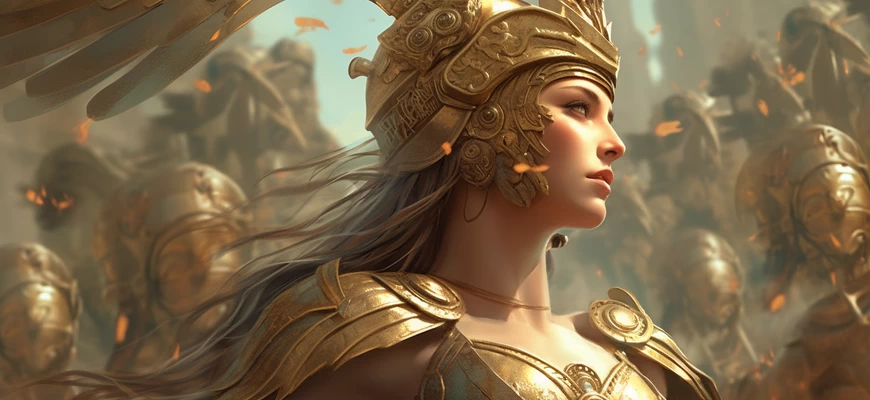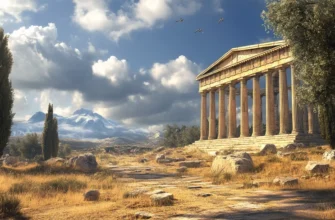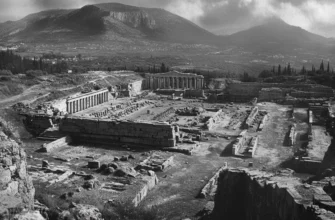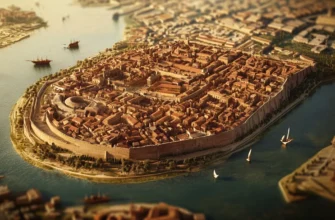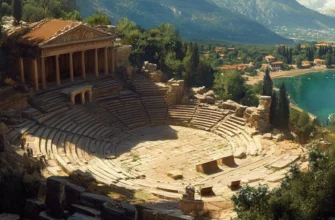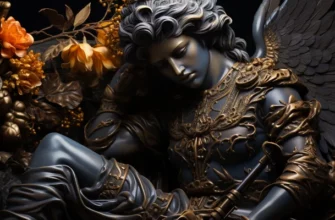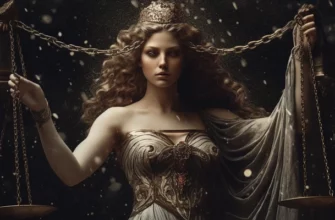Athena is the ancient Greek goddess of wisdom, war, and crafts. She symbolized intelligence, strategy, and the protection of heroes. Athena was revered in Greek mythology and had a significant influence on culture and art. Her image is still used today to represent strength, wisdom, and female power.
In ancient Greek mythology, Athena was considered the daughter of Zeus, the supreme god, and Metis, the personification of wisdom. However, her birth was extraordinary: Zeus swallowed Metis when she was pregnant with Athena, and Athena was born from Zeus’ head, fully armed and adult. As the goddess of wisdom and strategy, Athena played an important role in Greek mythology, was one of the most prominent deities, and was obsessed with the heroes she protected and endowed with military prowess.
- Athena as the goddess of wisdom and strategy
- Athena as the goddess of war and protector of heroes
- Epithets and attributes of Athena in a military context
- Athena and Ares: relationships with other gods
- Athena as the goddess of crafts and arts
- Athena as the patroness of architecture and understanding of crafts
- The symbolism and influence of Athena in the modern world
- The use of Athena’s image in culture and art
- The impact of the cult of Athena on the role of women in society
Athena as the goddess of wisdom and strategy
Athena was the embodiment of wisdom and strategy in Greek mythology. Her intelligence and prudence made her one of the most prominent goddesses. She was the patroness of science, intellectual work, crafts, and the arts. Athena possessed great knowledge and gave advice to heroes and sages, contributing to their success in wars and strategic affairs. Her image symbolizes the powers of mind, organization, and logic, making her one of the most revered goddesses in the ancient world.
Athena played an important role in many myths and legends of ancient Greece. One of the most famous is the myth of the competition between Athena and Poseidon for the right to become the patron of Athens.
According to the agreement, each god had to give the city a valuable gift. Poseidon struck the ground with his trident, and salt water gushed forth. But when Athena struck the ground with her spear, an olive tree grew out of the ground. The city’s inhabitants chose Athena’s gift because the olive tree symbolized peace and fertility, while Poseidon’s water could cause floods and soil salinization. Thus, Athena became the patroness of Athens and brought them the blessings of wisdom, peace, and civilization. H3: The Cult of Athena in Ancient Greece
Athena as the goddess of war and protector of heroes
Athena was a powerful goddess of war in Greek mythology. She was the patroness of warriors and heroes, endowing them with strength, courage, and military strategy. Athena accompanied heroes in battle, helping them defeat their enemies and defend their lands. She was also involved in the protection of justice and promoted the development of fairness. As a symbol of strength and military skill, Athena was revered in the Greek military cultural context and was the embodiment of the protector of heroes.
Epithets and attributes of Athena in a military context
Athena had various epithets and attributes that symbolized her military strength and protective qualities. Some of these included:
Aphroditoplis (Aphrodite-bearer) – she carried a shield with an image of Aphrodite, emphasizing her military nature and strength.
Parthenos (Virgin) – this epithet emphasized Athena’s unmarried status, reflecting her independence and autonomy.
Promachia (Archer) – she possessed unerring accuracy and precision in archery.
Aegis (Skin of the Amalthea Goat) – this was the shield she carried, often bearing the image of the Gorgon’s head, which struck fear into her enemies.
Niketa (Victorious) – this epithet emphasized her role as a symbol of victory and triumph.
These epithets and attributes reflected Athena’s power as a warrior goddess and her protective abilities, which made her respected and revered in the Greek military tradition.
Athena and Ares: relationships with other gods
Athena and Ares, the god of war, had a complex relationship in Greek mythology. Athena represented strategy, prudence, and military skill, while Ares symbolized brute force and bloodshed. They were often depicted in opposition or conflict. Athena disapproved of Ares’ disorder and violence, so she often restrained him and tried to reconcile him with reason and strategy. There were disputes and rivalries between them, but at the same time, they also cooperated in some military events. This relationship reflected the conflict between brute force and wisdom that arose in the context of war and battles in the ancient world.
Athena as the goddess of crafts and arts
Athena also played the role of patroness of crafts and the arts in Greek mythology. She was an image of skill and creativity, who favored craftsmen, artists, and various artisans. She was associated with various crafts, including pottery, weaving, blacksmithing, and many others. Athena provided inspiration, protected craftsmen in their work, and supported the development of the arts. She was also associated with wisdom, which gave her the ability to innovate and develop new techniques. As the goddess of crafts and arts, Athena held an important place in Greek culture and embodied the importance of creativity, talent, and skill.
She was considered the patroness of various crafts, including pottery, weaving, blacksmithing, carving, and many others. Athena was known for her skill and mastery in these fields, and she passed on her knowledge and skills to craftsmen. According to mythology, she taught people how to make various objects and master the craft.
Athena also played an important role in protecting craftsmen and their work. She was an image of skill and creativity, providing protection and inspiration to craftsmen. According to myths, she fought against untalented or unskilled craftsmen and provided support and assistance to those who showed talent and skill in their work.
Athena as the patroness of crafts reflected the importance of these crafts in Greek society. She symbolized the beauty, skill, and intelligence necessary for the successful performance of craftsmanship. Athena’s presence in crafts served as a reminder of the importance of manual labor, creativity, and art in ancient Greek culture.
Athena as the patroness of architecture and understanding of crafts
In Greek mythology, Athena is a prominent patroness of architecture and artistic understanding of crafts. Her presence and influence extend not only to physical construction activities, but also to the creative process and intellectual aspects of craftsmanship. Athena possesses wisdom and intelligence that help reveal the depth of craftsmanship and the embodiment of ideas in magnificent architectural works.
As the patroness of architecture, Athena provided architects with thoughtfulness and creativity, inspiring them to create beautiful and harmonious buildings. She embodied an understanding of proportion, symmetry, and aesthetic perception, contributing to the development of architectural art.
In addition, Athena understands the importance of crafts and supports artisans, helping them to improve their skills and understanding of their craft. She embodies the talent and prudence necessary for the successful practice of crafts, and encourages continuous improvement and thoughtfulness in the performance of craft tasks.
As the patroness of architecture and crafts, Athena reflects the combination of intellect, creativity, and skill that underlies highly valued architectural creations and craftsmanship. She inspires the craft community to be creative, develop their talents, and understand art.
According to legend, Athena was actively involved in major architectural projects, such as the Parthenon on the Acropolis in Athens. She provided her followers with the skills and inspiration to create magnificent structures that embodied harmony and aesthetics. Her epithet “Parthenos” (Maiden) indicates her value and importance in the field of architecture and crafts. She also met with other gods and heroes who sought her advice and support in their creative endeavors. Her presence reminds us of the importance of understanding crafts and craftsmanship in creating cultural heritage and expressing human creative potential.
The symbolism and influence of Athena in the modern world
Athena, as the ancient Greek goddess of wisdom, war, and crafts, leaves her mark on the modern world. She has become a symbol of wisdom, intelligence, and strength, inspiring many people in their pursuits and achievements. Athena’s symbols, such as her headdress—a helmet with a mask and an owl—are used in logos, brands, and cultural expressions that emphasize the values of wisdom, strategy, and intellectual mastery.
Athena’s influence in the modern world is evident in the relevance of her attributes. Her role as a symbol of wisdom encourages education, self-development, and the pursuit of knowledge. As a symbol of war and protection, she reminds us of the importance of peacemaking, humanism, and the responsible use of power. Her patronage of crafts and the arts emphasizes the importance of creativity, ingenuity, and craftsmanship in modern society.
Athena, as a symbol of the greatness and power of the feminine principle, also promotes equality, women’s emancipation, and emphasizes their important role in all areas of life.
Overall, Athena continues to influence the modern world as a symbol of wisdom, skill, and strength, reminding us of the values we can incorporate into our lives to achieve success, growth, and harmony.
The use of Athena’s image in culture and art
The image of Athena, the ancient Greek goddess of wisdom, has a significant influence on contemporary culture and art. She inspires creators and creates space for creative expression. One of the most famous examples of the use of Athena’s image is her depiction in paintings, sculptures, and stained glass. She is portrayed as an expressive, strong, and intelligent woman, symbolizing the power of wisdom and intellect.
In addition, Athena appears in literature, drama, and cinema, where she acts as a symbol of courage, self-control, and bravery. Her myths and legends inspire authors to create powerful female characters with Athena’s distinctive traits.
The image of Athena is also used in contemporary fashion and design. Her elements, such as her helmet, owl, and attributes, can appear on clothing, accessories, and jewelry, giving them a strong symbolic meaning.
In general, the use of Athena’s image in culture and art demonstrates respect for her important role in Greek mythology and the significance of her attributes, such as wisdom, strength, and beauty. This allows us to maintain a connection with ancient traditions and feel the effects of her influence in the modern world.
The impact of the cult of Athena on the role of women in society
The cult of Athena had a significant impact on the role of women in Greek society and affected their status and opportunities. As the goddess of wisdom, Athena had a strong influence on education and intellectual development. This led to women gaining some access to education, which was rare at the time. They had the opportunity to acquire knowledge and develop their intellectual abilities.
In addition, Athena was a symbol of military strength and a protector of heroes. This gave women the opportunity to express their strength and will, and to perform protective functions in society. They could become warriors, athletes, or actively participate in public life.
Thanks to the image of Athena, who was self-sufficient and independent, women were given a certain freedom in decision-making and self-determination. They were able to express their talents, gain self-confidence, and achieve success in various areas of life.
However, it should be noted that these effects were limited to Greek society, where women were still under the control and restrictions of men. Nevertheless, the cult of Athena sparked some changes in the role of women, encouraging them to participate more actively in public life and develop their potential.
